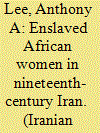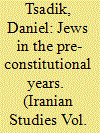| Srl | Item |
| 1 |
ID:
111193


|
|
|
|
|
| Publication |
2012.
|
| Summary/Abstract |
Fezzeh Khanom (c. 1835-82), an African woman, was a slave of Sayyed 'Ali-Mohammad of Shiraz, the Bab. Information about her life can be recovered from various pious Baha'i histories. She was honored, and even venerated by Babis, though she remained subordinate and invisible. The paper makes the encouraging discovery that a history of African slavery in Iran is possible, even at the level of individual biographies. Scholars estimate that between one and two million slaves were exported from Africa to the Indian Ocean trade in the nineteenth century, most to Iranian ports. Some two-thirds of African slaves brought to Iran were women intended as household servants and concubines. An examination of Fezzeh Khanom's life can begin to fill the gaps in our knowledge of enslaved women in Iran. The paper discusses African influences on Iranian culture, especially in wealthy households and in the royal court. The limited value of Western legal distinctions between slavery and freedom when applied to the Muslim world is noted.
|
|
|
|
|
|
|
|
|
|
|
|
|
|
|
|
| 2 |
ID:
168994


|
|
|
|
|
| Summary/Abstract |
This article presents a very rare manuscript of a Muntakhab al-Suwar (selection of Qur’anic chapters) calligraphed by Ibrāhīm Sulṭān b. Shāhrukh. This manuscript was transcribed in large format in Ramaḍān 830 AH/June 1427 AD and endowed to the holy shrine of Shāh-Chirāgh in Ramaḍān 834 AH/May‒June 1431 AD. Therefore, it is considered to be one of the last known works calligraphed by Ibrāhīm Sulṭān. It is kept in the Pars museum in Shiraz. In this article, the unique codicology and special characteristics of this masterpiece are studied, and the important historical aspects of Ibrāhīm Sulṭān and the art works attributed to him are elaborated. The style of his calligraphy will also be examined to find out the sources of inspiration for his distinct style.
|
|
|
|
|
|
|
|
|
|
|
|
|
|
|
|
| 3 |
ID:
110881


|
|
|
|
|
| Publication |
2010.
|
| Summary/Abstract |
During the Constitutional years (1906-11) the legal status of the Jews and some other religious minorities improved, even if only to a limited extent. Can one assume that this change in the legal status of the Jews reflected changes in the public's actual treatment toward the Jews in reality during the days leading up to the Constitutional Revolution in 1906? To an extent, the answer is in the affirmative. The present article argues, however, that the real life situation of the Jews in the years leading up to the Constitutional Revolution was still often one of abuse and occasional persecution. To prove this contention, section I of the article presents some such cases. Section II establishes some of the reasons for the attacks on the Jews-not only religious, but also economic and socio-political ones, as well as briefly suggesting certain recurring paradigms surrounding it. Section III looks at one case study from November 1905 in the city of Shiraz. Finally, this preliminary research ends with some concluding remarks.
|
|
|
|
|
|
|
|
|
|
|
|
|
|
|
|
| 4 |
ID:
101291


|
|
|
|
|
| Publication |
2011.
|
| Summary/Abstract |
As a key primary source for the history of the eleventh-century Isma'ili majlis, the Fatimid chief missionary al-Mu'ayyad fi al-Din al-Shirazi's autobiographical Sira offers a prime opportunity to consider the application of centralizing features of the Fatimid state in eleventh-century Buyid Shiraz. Previous studies on the Fatimid majlis have raised questions about an Isma'ili core curriculum as well as the intended audience/s of Fatimid da'wa teachings. This article situates al-Mu'ayyad's memoir in the broader context of the Persian and Arabic historiographical traditions in order to provide new insights into the transmission of Isma'ili doctrines in different social settings outside of Fatimid Cairo. It concludes that Abu Kalijar's study sessions with al-Mu'ayyad suggest that Qadi al-Nu'man's Kitab Da'a'im al-Islam was used as a core text for introducing some of the main principles of Fatimid religio-political rule in addition to Isma'ili doctrines to non-Isma'ili audiences.
|
|
|
|
|
|
|
|
|
|
|
|
|
|
|
|